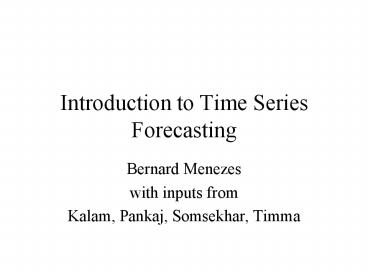Introduction to Time Series Forecasting - PowerPoint PPT Presentation
1 / 35
Title:
Introduction to Time Series Forecasting
Description:
A sequence of observations of a quantifiable phenomenon recorded in ... come and go notice the kinds of spectacle frames 'fashionable' over the years) ... – PowerPoint PPT presentation
Number of Views:79
Avg rating:3.0/5.0
Title: Introduction to Time Series Forecasting
1
Introduction to Time Series Forecasting
- Bernard Menezes
- with inputs from
- Kalam, Pankaj, Somsekhar, Timma
2
Time Series
- A sequence of observations of a quantifiable
phenomenon recorded in increasing order of time
3
Time Series - Examples
- Stock price, Sensex
- Exchange rate, interest rate, inflation rate,
national GDP - Retail sales
- Electric power consumption
- Number of accident fatalities
4
Goals
- To UNDERSTAND the observed series
- To look into the future (by deducing from the
observed patterns in the past)
5
Forecasting vs. Extrapolation
6
Error Measures
- RMSE
- MAE
- MAPE
- Max error
7
Patterns in the data
- Trend (linear, quadratic, S-shaped, etc.)
- Seasonality (by month or quarter of the year, day
of the week or time of the day) - Cyclicity (fashions come and go notice the
kinds of spectacle frames fashionable over the
years)
8
Stationarity
- Should we care?
- Strict stationarity, covariance stationarity
9
Covariance, ACF, PACF
- What do these tell us?
10
Series Decomposition
- Many time series can be decomposed into following
components - Trend (T) Non-periodic component of time series
- Cyclical (C) Periodic component with period
longer than seasonal period - Seasonal (S) Recurring pattern (periodic
component). - Irregular (I) Residual after removing all three
components above - Whats the point?
11
Some Models for Decomposition
- Trend, seasonality and irregular component can
combine in various ways such as - Model 1 T S I
- Model 2 T (S I)
- Model 3 T S I
- The multiplicative model is more appropriate for
demand sales
12
Cyclical Component?
- Generally trend and the cyclical component are
analyzed/estimated together for ease of model
construction
13
Experiment 1 MAPEs for different models
14
(No Transcript)
15
Experiment 2 Does Decomposition help?
- indicates use of decomposition.
16
With and without Decomposition
17
With and without Decomposition (contd.)
18
Experiment 3 Which error measure do we use for
the decomposed series?
19
(No Transcript)
20
(No Transcript)
21
(No Transcript)
22
(No Transcript)
23
Factoring expert advice
- How many experts do we select?
- Which of these is used for a particular point
forecast? - How do we weigh the advice of the experts?
- Do we dynamically change the above? How? Why?
24
(No Transcript)
25
(No Transcript)
26
AR1
- 0.5X(t-1)eps(t)
27
(No Transcript)
28
AR1
- 0.9X(t-1)eps(t)
29
(No Transcript)
30
AR1
- 0.2X(t-1)eps(t)
31
(No Transcript)
32
AR2
- 0.3X(t-1)0.5X(t-2)eps(t)
33
(No Transcript)
34
MA1
- 0.8eps(t-1)eps(t)
35
(No Transcript)































